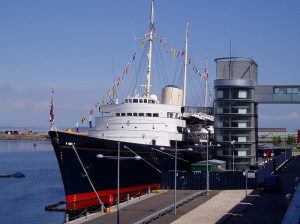Twenty-four years after the last British royal yacht, HMY Britannia, was retired and became a museum in Edinburgh, Boris Johnson’s government has decided to commission a replacement. The ship’s name and the degree to which it will explicitly be a built for the use of the royal family have not yet been publicly revealed, but the messaging around the concept has evolved. According to the prime minister, “This new national flagship will be the first vessel of its kind in the world, reflecting the U.K.’s burgeoning status as a great, independent maritime trading nation.”
The terminology is worth noting: a “national flagship.” This is distinct from the fleet flagship, a role already taken by the new supercarrier HMS Queen Elizabeth. Although details remain scarce, the new vessel will apparently be crewed by officers and enlisted personnel from the Royal Navy, though it will not be a commissioned naval vessel. A warship, after all, does send a certain message, and not one which is always conducive to the improvement of peaceful relations between states.
There are, of course, very real questions about whether spending at least 200 million pounds on such a flagship – not including annual operational costs and the very real possibility of construction cost overruns – makes sense at a time when the U.K. is both slashing its overseas aid budget and facing a 17.4 billion pound shortfall in the defense equipment budget. Nevertheless it is actually worth considering what a notional national flagship might accomplish.
Much of the British government’s case for the ship, as it pursues new economic relationships outside the European Union, is its value in serving as a venue for the negotiation of trade agreements. That idea, along with Europe’s general lack of coastal capital cities and the British government’s avowed desire to build its presence farther afield, might well see the ship spend much of its time in the Asia-Pacific.
But the idea that a glitzy national flagship will somehow improve outcomes in trade negotiations isn’t an argument that, if you’ll pardon the expression, holds much water. Modern trade agreements are incredibly complex and technical, pieced together over months and years by specialist negotiating teams rather than hammered out by senior ministers admiring a harbor view over wine and canapés.
The other argument is that a mobile piece of British territory might provide senior officials with secure facilities to plan and communicate back home during complex or politically sensitive events. But this raises the question of value for money and what kind of ship is being procured. If the point is simply a glitzy showcase boat – a politically difficult sell, given the taxpayer monies involved – 200 million pounds would buy a large but by no means world-beating vessel. Adding functionality like secure communications facilities or the ability to be used as a disaster refuge or hospital ship would take the project into a completely separate military-spec cost bracket, where even a humble offshore patrol vessel can cost a comparable amount. In other words, the quoted figure suggests either a vessel that will not meet the expansive promises being made for it, or an acknowledgement that the real cost is higher but politically untenable to state upfront.
That all suggests that Britain – and other democratic nations that might seek to emulate the idea of a non-military national flagship while being accountable to taxpayers – pursue alternative ideas. After all, numerous countries have historical ships in commission as living links to their histories – some of which are even capable of international cruises. Like nautical “restomods” – classic cars updated with modern mechanical and safety features – they combine historical value with training and symbolic purposes.
Alternatively, a “national flagship” could be a ship that provides a genuinely useful scientific or logistical service – deep-sea exploration, say, or ocean surveillance – with a set of accommodation features, which would permit it to be used for high-visibility events as needed. This is actually a model the British government already uses for its primary VIP transport aircraft, which has comfortable internal accommodations and a Union Jack paint scheme, but remains a functional Airbus A330 MRTT tanker/transport aircraft.
On the outer edge of plausibility, the idea of a national flagship could be combined with unusual but potentially promising design ideas. If hundreds of millions in taxpayer money are going to be spent, why not push the design envelope? Instead of a royal yacht, why not a royal trimaran, a royal rotor ship, a royal hydrofoil, or a royal ekranoplan? After all, if the point is to showcase technical ingenuity, creativity, and design, wouldn’t that be, if nothing else, a more interesting way to do it than just another superyacht?































